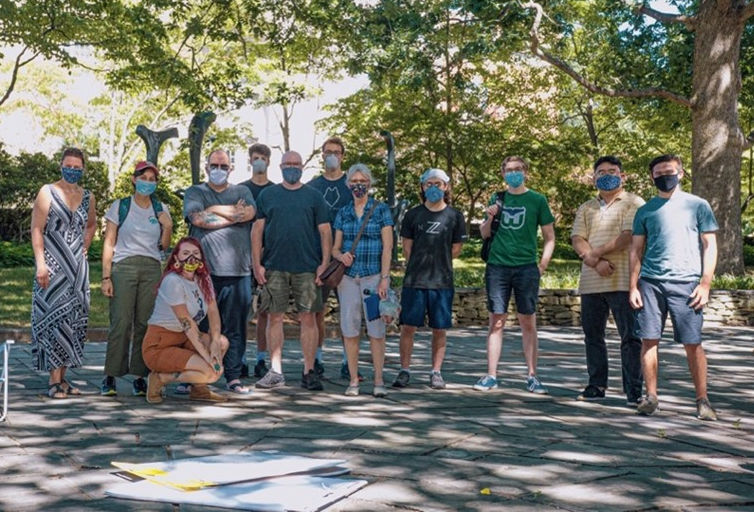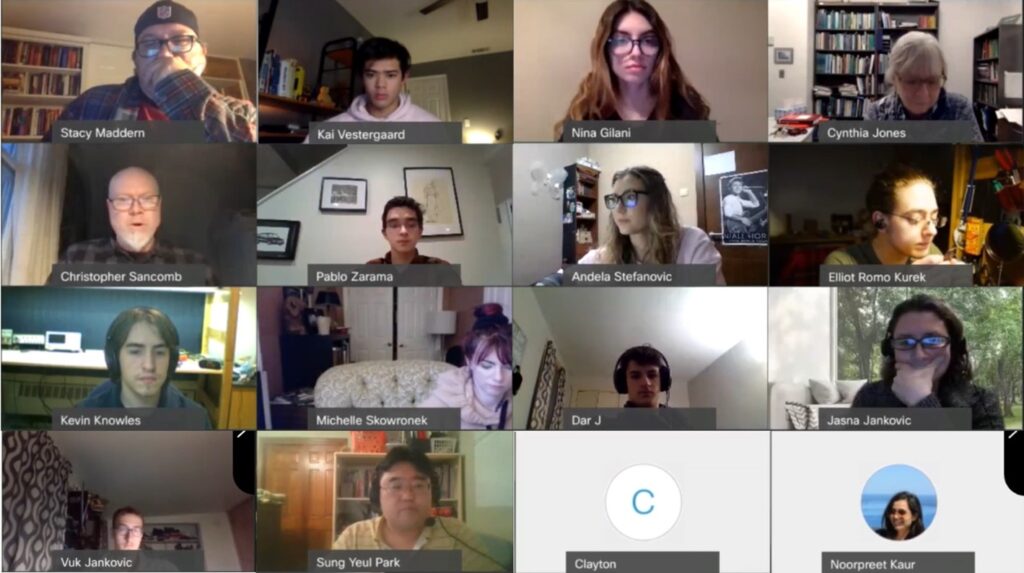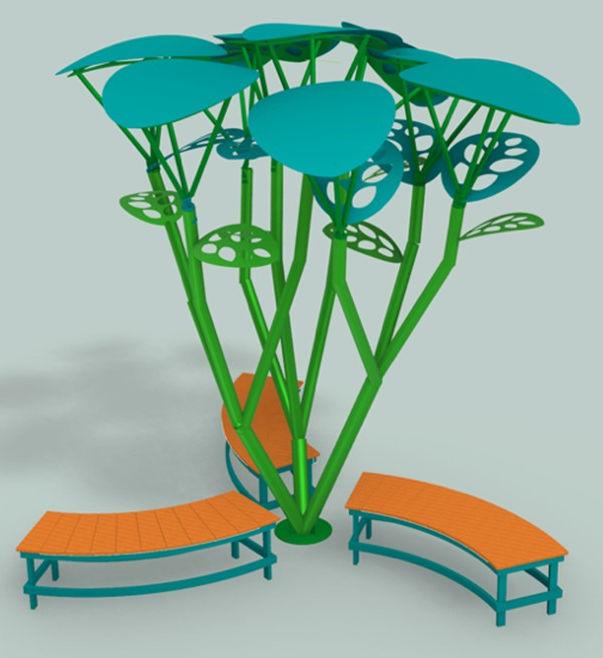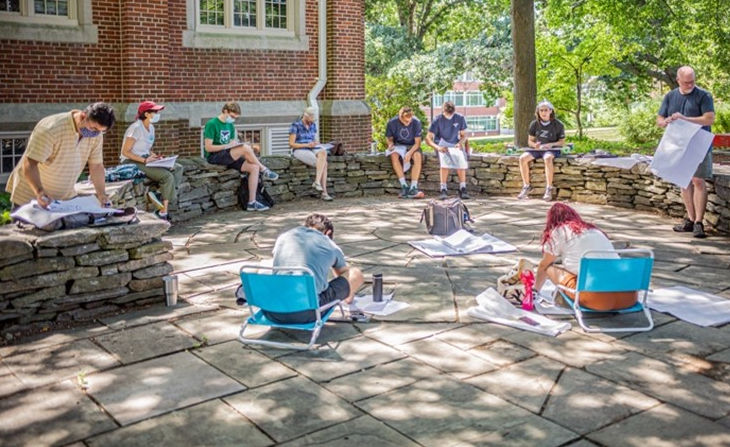UConn’s STEAM Team: Solar Trees and the Power of Community
By: Olivia Ortegon and Margot Wentzel
When one imagines solar power, the image that typically comes to mind is one of industrial, black or blue panels arranged in a formulaic, geometric pattern. Words that do not normally come to mind are those such as organic, natural, or even beautiful. But there is one team at UConn looking to change that.
Meet the “STEAM Team,” a team of individuals from departments of engineering, industrial design, biology and sociology. Their goal is to build a solar powered tree that is both functional and engaging. Dr. Jasna Jankovic, who works in the Department of Material Sciences and Engineering as well as at the Center for Clean Energy Engineering, conceived the idea of putting a solar tree in the middle of campus, but it was put off as a passion project for some time—that is, until the opportunity arose for funding and a chance to pursue her idea. Dr. Jankovic met with Dr. Leslie Shor, the Associate Dean for Research and Graduate Education, who suggested that she should apply for a UConn STEAM grant to fund her project (Science, Technology, Engineering, Arts and Math). Dr. Jankovic then partnered with Professor Chris Sancomb from Department of Art and Art History and recruited several other faculty at UConn including Dr. Cynthia Jones, Dr. Sung Yeul Park, and Dr. Stacy Maddern to write the project proposal and assemble the rest of their team.

Members of the STEAM team gather during a meeting in fall 2020.
The project officially started in May 2020, and began with more questions than answers. The team had to find ways to bring together all of their disciplines and visions to create a tangible structure. They began by asking, “How can art inform science, and vice versa?” The STEAM Team involves graduate, undergraduate and high school students of very diverse backgrounds.
“We all agree that we want to make the world a better place and that we can use technology to do it,” says Michelle Skowronek, one of the Urban and Community Studies members of the team. “We agree on the foundational aspect of the project—we want to make a nice place for people to enjoy their lives at.”
Elliot Romo Kurek, an undergraduate student working on the design side of the project, shared his thoughts on the team’s goal. “We hope to accomplish integration of sustainable energy into something beautiful, not brutish or ugly but rather making it a nice thing to be around. A lot of solar [energy] is not about that.”
The tree will be created with environmentally sensitive materials and have a unique organic design while still maintaining functionality and efficiency. It will have solar panels on its leaves that will directly power a battery within the tree. There will be power outlets for students to charge their phones and laptops, and there will also be lights underneath the tree’s leaves. The tree is intended to be over 12 feet tall, and will provide a convenient meeting place for students to sit outside and recharge. Ideally, there will be modular seating around the tree to create an atmosphere of relaxation mixed with learning. The team hopes to have a small solar-powered kiosk with an interactive technological tool to learn about the tree. The tree will be portable so that it can be moved to different areas on campus, effectively creating a dynamic environment and giving UConn students and faculty something exciting to look forward to as they look for where the tree moves next.
The main goal of this project is to raise awareness for clean energy sources and to teach others more about solar energy, as well as encourage a dialogue about our interactions with nature. The project epitomizes interdisciplinary learning among students and faculty alike. Professors and students from various disciplines can also use the tree for research and would be able to collaborate and perform their research together.
Dr. Cynthia Jones, advising the biology behind the tree, shared her perspective. “We want to add research potential to the project, including modules with different capacities for biological mimicry that can address questions about how sizes and shapes of leaves influence their function. We want there to be an educational aspect to the tree so that it is not just a static object in space, and we want to provide interpretation of the data output.”

Members of the team meet virtually once a week to discuss their ideas and share progress reports.
Some challenges the team faced during their project included the obvious challenge of working during the COVID-19 pandemic. Before the pandemic, Dr. Jankovic and Professor Sancomb had envisioned everyone working closely together on an in-person collaboration. A pivot to virtual meetings made producing progress reports and actually building the tree challenging. The team meets once a week on line to discuss their progress and ideas, and they are still able to work together and contribute all of their ideas equally.

A digital model of what the tree could look like once it is on campus.
The essence of STEAM Tree is to bring people together across diverse disciplines and backgrounds, including students, professionals, general public and families, to learn and experience science and art in a holistic and natural way. This tree is the perfect tool to do so. Not only is it created through collaboration, but it can also continue to foster learning across many subjects at UConn, such as art & design, biology, engineering, and social sciences. The team hopes that the project will expand beyond just a few prototype trees to become a group of even larger trees—their end goal is to create an oasis on campus where people can get together and have lectures or hang out with friends. “We want to use this as a tool to find new approaches in education,” says Dr. Jankovic. “It’s important to have a space where people can get together and be immersed in learning, science, discussion, and diversity. We can all be present and in the moment together.” “Another goal is to develop a deeper understanding of interdisciplinary collaboration, and think of new way of facilitating that work in future endeavors, and teaching others how to do that in the future as well,” says CoPI Professor Christopher Sancomb, who works on the design and fabrication of the project. To this point, the project is also unique due to its application of sociological and collaborative artistic design ideas in the process of teaching others about scientific and technological aspects of solar power
There has already been a great deal of learning achieved among the members of the STEAM team, from the high school level to the faculty and professors. Kai Vestergaard, a senior in high school working on the design team states, “It’s a new experience. I haven’t been on this type of team before where there’s professionals from all different types of departments and we work on making prototypes, doing research, and the actual fabrication [of the project].”
Dar Jankovic, another high school student on the team, shares, “Being on the team opens up a lot of opportunities. You get to learn a lot of new experiences including what to study in college if you decide to go. Participating in this project provides a lot for you.”
Dr. Stacy Maddern, professor of Urban and Community Studies, shared his thoughts about the future impact of the project. “It’s a great service learning model. I think that when you have a way in which people can learn from each other, learning through doing is the future of education. When you can create a model with a focus on STEM but then include humanities in it as well, this is an excellent model for how service learning can go on. It tears down the walls of the classroom. Everybody’s glass is half full here, and it demonstrates what possibilities can come from communities.”
See below for bios of the STEAM Team.
Dr. Jasna Jankovic is an Assistant Professor at the Materials Science and Engineering Department, and is part of C2E2 faculty focusing on clean energy solutions. She initiated the idea of the STEAM Tree to attract faculty and students of interdisciplinary backgrounds to clean energy and sustainable solutions.
Professor Chris Sancomb is an Assistant Professor in the new Industrial Design program in the School of Fine Arts with a research focus of designing socially interactive exhibits and environments. He joined the STEAM Tree project as Co-PI to explore ways design could facilitate interdisciplinary collaboration, and to develop an artistic clean energy installation that is accessible to the public.
Dr. Cynthia Jones is a Professor of Ecology and Evolutionary Biology who studies leaf shapes and plant architectures from an evolutionary and functional perspective.
Dr. Sung Yeul Park is an Associate Professor at the Electrical and Computer Engineering Department, and is part of C2E2 faculty focusing on renewable energy integrations. He joined the STEAM Tree as senior personnel, and his role is to consult electrical design and interface solutions.
Dr. Stacy W. Maddern began teaching at UConn as an adjunct professor in 2014 and has recently joined the full-time faculty in Urban and Community Studies. He has previously taught at New York University, the University of Hartford, and Central Connecticut State University. His scholarly interests include community theory, social capital, citizen engagement, organizational theory, urban social movements, and the history of education Dr. Maddern will focus on studying the social interactions around the STEAM Tree.

Members of the STEAM team social distance on campus to draft their first design ideas for the project.
Andela Stefanovic is a junior majoring in Computer Science and Engineering with minors in Astrophysics and Human Rights. She works under Materials Science and Engineering Department on this project, on modelling solar cells, while also being part of the design work group and social media team.
Clayton Ehasz is an alumnus of the University of Connecticut, and graduated with a degree in Electrical Engineering in December 2020. He participated in the design of the STEAM Tree, focusing primarily on the electrical systems.
Dar Jankovic is a student at Edwin O. Smith Highschool. He works with the Design Team in the STEAM Tree project and helps with contributing ideas to the group.
Elliot Romo Kurek is a fourth-year BFA Student with a focus in Sculpture and Ceramics. His background lies in fabrication and small batch production in materials including Wood, Ceramics, and Metal.
Kai Vestergaard is a senior high school student at Glastonbury High School. He is part of the design team and is interested in finding ways to make solar energy more appealing.
Kevin Knowles is a junior in electrical engineering with interests in PCB design, RF, and the internet of things. When he’s not working on electronics for school, he enjoys amateur radio, camping, astronomy, and photography.
Michelle Skowronek is an Urban & Community Studies Major who is currently in the fast track program for a Master in Public Administration with a focus on Urban Planning. Michelle examines the design process of the STEAM tree so that It fosters inclusivity, equality and sustainability within the community. Michelle uses biomimetic, circular city and new urbanist principles as a basis for her approach.
Naime Gilani is a second-year undergraduate student studying Biological Sciences. Her goal is to one day work as a Public Health professional. In working on the STEAM Tree, she hopes to establish a more forward-thinking and environmentally conscious culture at UConn that emphasizes the importance of the environment on our health.
Noorpreet Kaur is a PhD student in the Ecology and Evolutionary Biology department and a member of the Arboretum Committee at UConn. She enjoys walking in nature and is interested in developing clean energy resources to mitigate the climate change.
Pablo Zarama is a Materials Science and Engineering Major from the class of 2023, and is passionate about all things STEM related. Pablo is working under Dr. Jankovic in the STEAM Tree project.
Raisa Vazquez is a junior in the school of Fine Arts’ individualized major program with a focus on industrial design. She is one of the students on the design team for the STEAM Tree.
Vuk Jankovic is a student at the University of Connecticut in his freshman year. He is working towards his undergraduate degree in Psychological Sciences. He joined the STEAM tree group because he became interested in clean energy and it is a great educational experience.

